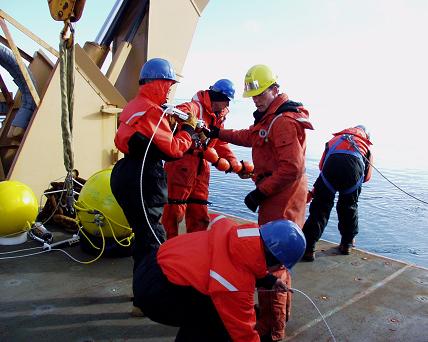More moorings
Gerhard Behrens |
| Nothing fancy today, just more moorings. Remember, a mooring is a piece of ocean measuring equipment that stays
in the water. But, today’s moorings are different than yesterday. |

The CTD mooring strung out on the aft deck. |

Building another CTD mooring on the deck. |
This kind is a long, long string of things. At the bottom is a weight to hold it on the ocean floor. The
electronic tool that lets go of the weight when the scientists want the whole thing back follows the weight. A big
float goes next. It will bring the whole thing to the top. On top of the big float is a string of measuring tools
and more floats. At the top is a final float and the PEIPS Avalanche Beacon, an electronic tool that signals where
the mooring is. |
| The scientists are measuring salt, temperature, and the pushing force of the water. In oceanography language,
you would say: salinity, temperature, and pressure. Take a look at the diagram to see how the mooring is put
together. The mooring technicians must follow these directions. Then, look at the pictures to see how everything is
lined up before it is placed over the stern. The mooring technicians start with the top, and the last thing to go
over the edge is the weight and biggest float. |

Chris Moser with another completed mooring. Now what? |

Carefully put the mooring overboard. |
The scientists will come back for this string of equipment in the spring of 2005. You can imagine how the
scientists could worry about their moorings. A piece of equipment could stop working, the sea water could corrode
something, or an iceberg could rip it away. |
| Check out the Fun Facts link to learn more about icebergs or sea ice. Yup, they are
different! |

The last part to go in is the big float, a release tool, and a weight. |

The diagram that tells how to build the mooring |

Ron Lindsay programs the equipment. |

Bob McCarthy decorates a float with a cat. |

Pete Gamble, the maestro of moorings. |
